1、Guangdong's GDP leads the nation for 36 consecutive years
Within China's economic landscape, Guangdong has consistently distinguished itself by charting a unique path of development. In 2024, this pioneer of reform and opening-up recorded an impressive GDP of RMB 14 trillion, securing its position as the nation's leading economic powerhouse for 36 consecutive years. This achievement exemplifies the remarkable success in developing a world-class city cluster.
Provincial GDP: Surpassing RMB 14 trillion, maintaining the top rank nationwide for 36 consecutive years.
Total import and export volume: Surpassing RMB 9 trillion, marking a 9.8% year-on-year increase. This total has ranked first in the country for 39 consecutive years, contributing 38.7% of the country's trade growth.

The value-added industrial output of above-scale enterprises increased by 4.2%, with approximately 74,000 above-scale industrial enterprises.
Local general public budget revenue: RMB 1.35 trillion, maintain the top position nationwide for 34 consecutive years.
Total tourism revenue exceeded RMB 1 trillion, while the gross value of marine production exceeded RMB 2 trillion.
The number of business entities increased by 980,000, reaching over 19 million, including more than 8.3 million enterprises. Both figures ranked first nationwide.
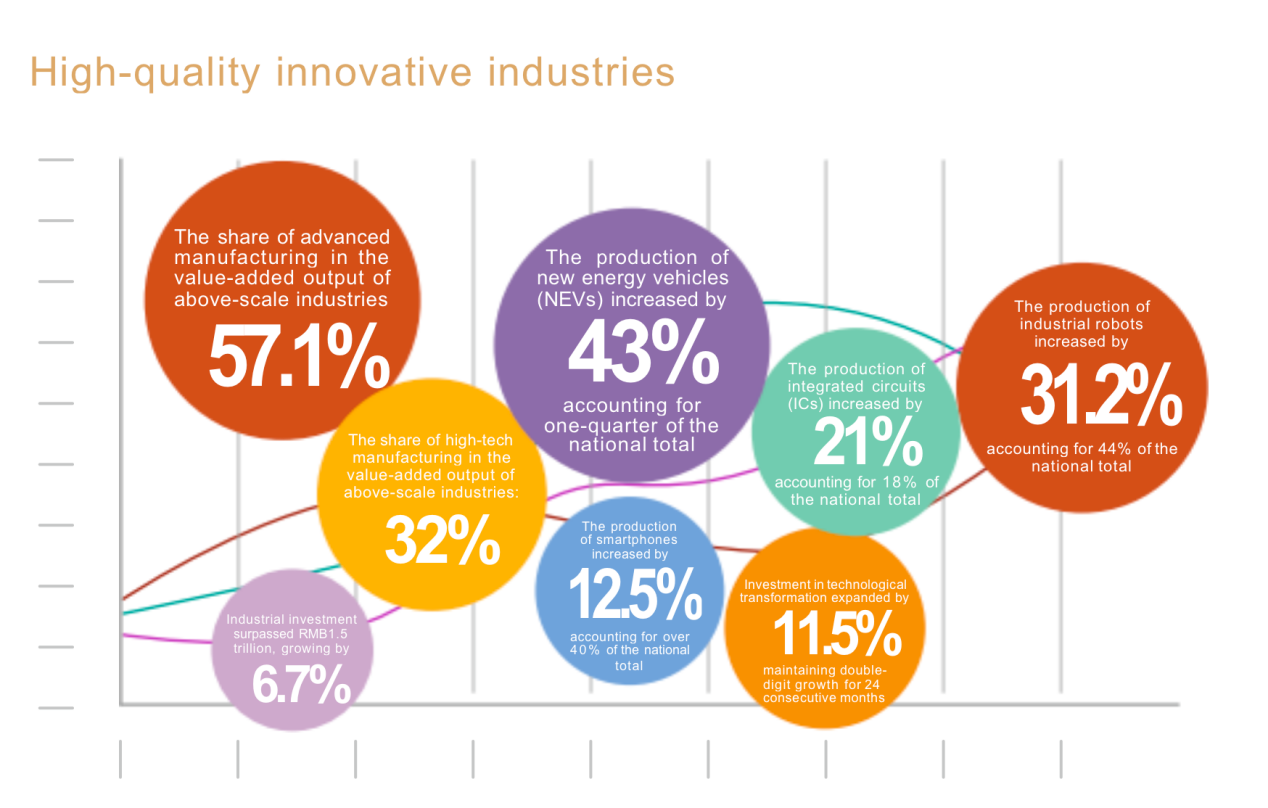
In 2024, the province's expenditure on R&D reached around RMB 510 billion, representing an R&D investment intensity of approximately 3.6%. The province is home to around 77,000 high-tech enterprises and has topped national rankings for eight consecutive years in regional innovation capacity. The Shenzhen-Hong Kong-Guangzhou science and technology cluster has ranked second globally for five consecutive years in the Global Innovation Index (GII).
The total retail sales of consumer goods in the province reached RMB 4,787.28 billion, continuing to rank first nationwide. Among China's seven trillion-yuan-level consumer cities, Guangdong is home to two: Guangzhou and Shenzhen. Data shows that in 2024, Guangzhou recorded total retail sales of consumer goods of RMB 1,105.577 billion, while Shenzhen reached RMB 1,063.77 billion.
Source | 2025 Invest Guangdong
2、Guangdong's integrated measures on foreign trade, foreign investment, outsourcing services, international economic cooperation, and foreign talent
Guangdong has launched integrated measures on foreign trade, foreign investment, outsourcing services, international economic cooperation, and foreign talent, seeking to promote high-level opening up.
In 2024, Guangdong's total foreign trade volume reached RMB 9.11 trillion, a 9.8% year-on-year increase. Its contribution to the national trade growth was 38.7%, accounting for 20.8% of China's total foreign trade volume. Among that, export volume reached RMB 5.89 trillion, growing by 8.4%, and import volume stood at RMB 3.22 trillion, increasing by 12.5%.
Guangdong has maintained the top position in total foreign trade volume for 39 consecutive years and attracted 26,000 newly established foreign-funded enterprises, a growth of over 20%.
From the perspective of market structure, traditional markets performed steadily, while the development of emerging markets was notably effective.
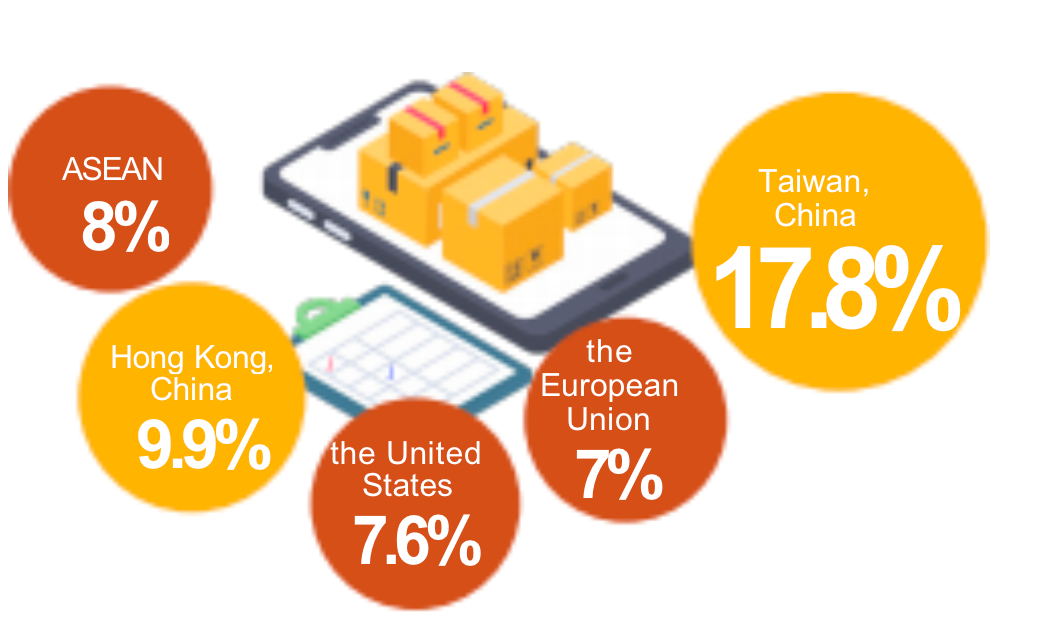
In 2024, the top five trading partners — ASEAN, China's Hong Kong SAR, the United States, the European Union, and China's Taiwan region — all saw positive growth in trade with Guangdong, increasing by 8%, 9.9%, 7.6%, 7%, and 17.8%, respectively. Its trade with the 17 countries in the Middle East grew by 8.8%, that with Latin America by 16.7%, and that with the five Central Asian countries by 40.3%. Its trade with Belt and Road partner countries increased by 9.4%, accounting for 38% of the province's total foreign trade volume.
Conventional three major exports in foreign trade include mobile phones, computers, and household appliances. The new three major exports in foreign trade are NEVs, photovoltaic (PV) products, and lithium batteries.
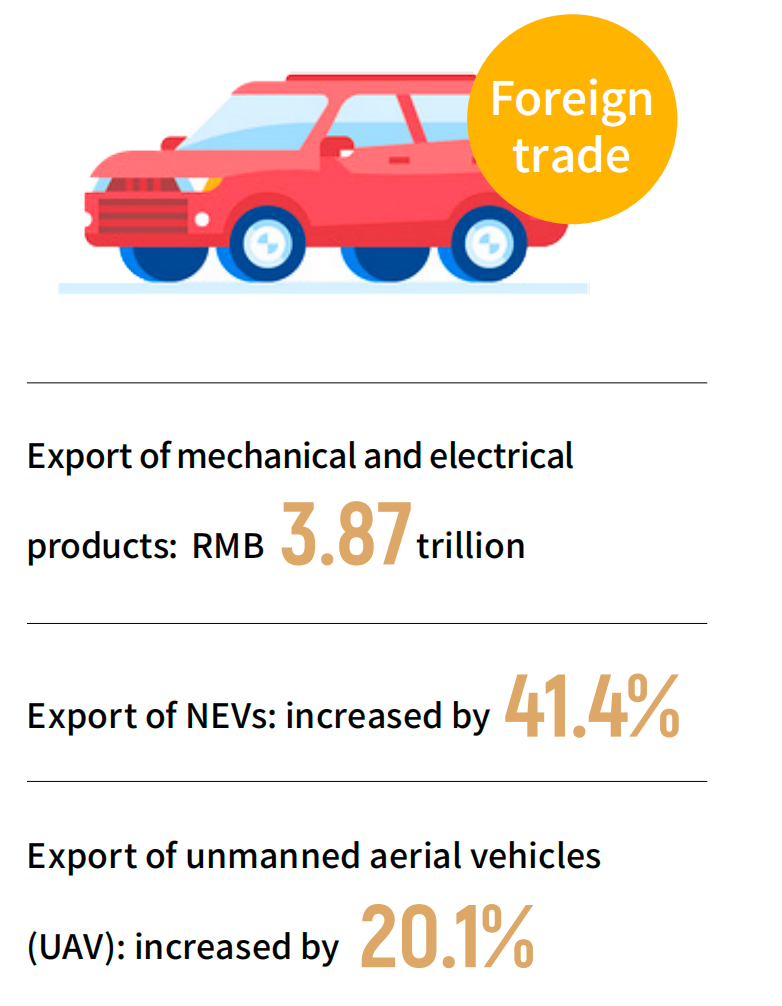
In 2024, Guangdong saw the establishment of 26,213 new foreign-invested enterprises, with actually utilized foreign capital amounting to RMB 101.2 billion. By the end of 2024, Guangdong was home to a total of 215,100 registered foreign-invested enterprises, marking an 8.0% year-on-year increase and accounting for one-quarter of the national total, thus reinforcing its status as a national leader in attracting foreign investment.
Securing overseas orders
The Canton Fair, held biannually, attracted approximately 500,000 overseas buyers. Guangdong achieved a transaction volume of USD 19.48 billion, a 26.5% increase.
A total of 300 "Cantonese Businesses Going Global" overseas exhibitions were meticulously organized and launched, supporting 25,500 enterprise participations in securing international orders, resulting in a transaction volume of USD 10.86 billion.
In 2024, a total of 1,933 projects, valued at RMB 2.26 trillion, were secured at the Global Investment Promotion Conference for the Guangdong-Hong Kong-Macao Greater Bay Area; the projects secured at the previous two sessions are under accelerated implementation, with an implementation rate of 76.8% and an investment amount of over RMB 1 trillion.
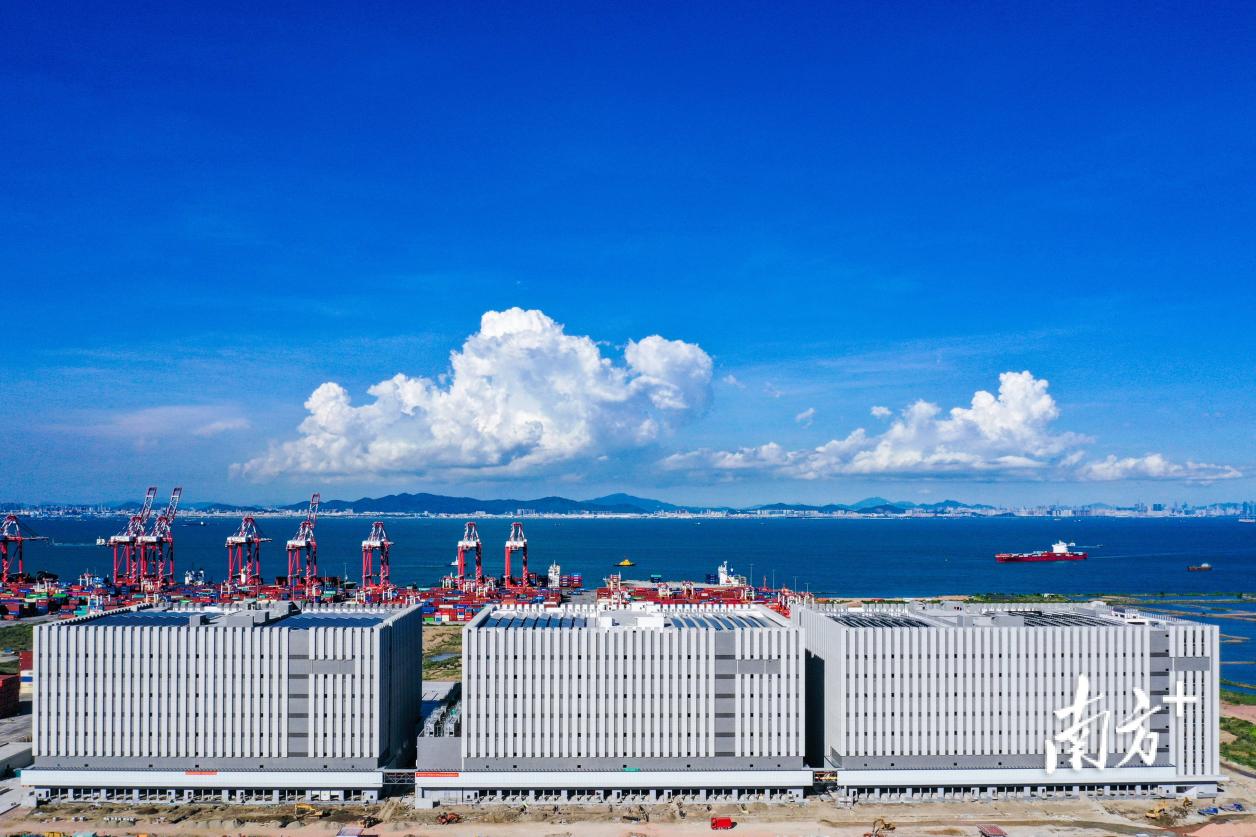
Cross-border e-commerce continues to lead the nation in scale
In 2024, Guangdong's cross-border e-commerce import and export volume reached
RMB 745.4 billion, accounting for more than one-third of the national total and was the largest in the country.
By the end of 2024, a total of 19,437 cross-border e-commerce enterprises in Guangdong Province were registered with customs, ranking first nationwide.
Strong momentum of industry-trade integration
Guangdong has developed numerous industrial clusters, including nine at the trillion-yuan level, two at the 500-billion-yuan level, and seven at the 100-billion-yuan level. 70% of global consumer drones, 40% of global smartphones, one-third of China's industrial robots, one-fourth of China's NEVs, and one-fifth of China's ICs are produced in Guangdong.
Source | 2025 Invest Guangdong
3、Urban characteristics and coordinated development
In recent years, Guangdong has optimized the special layout of new urbanization, expanded city clusters and metropolitan areas, and promoted coordinated development among cities of all sizes to reduce administrative barriers and improve industrial landscape.
The provincial government has released development plans for five metropolitan areas: Guangzhou, Shenzhen, the West Bank of the Pearl River Estuary, Shantou-Chaozhou-Jieyang, and Zhanjiang-Maoming. The planning period runs from 2023 to 2030, with a vision to 2035, aiming for multi-engine-driven coordinated development across Guangdong Province.
Guangzhou Metropolitan Area
Work to serve as the province's main driver for high-quality growth, a national model for high-quality urban integration, and a national leader in manufacturing and services integration.
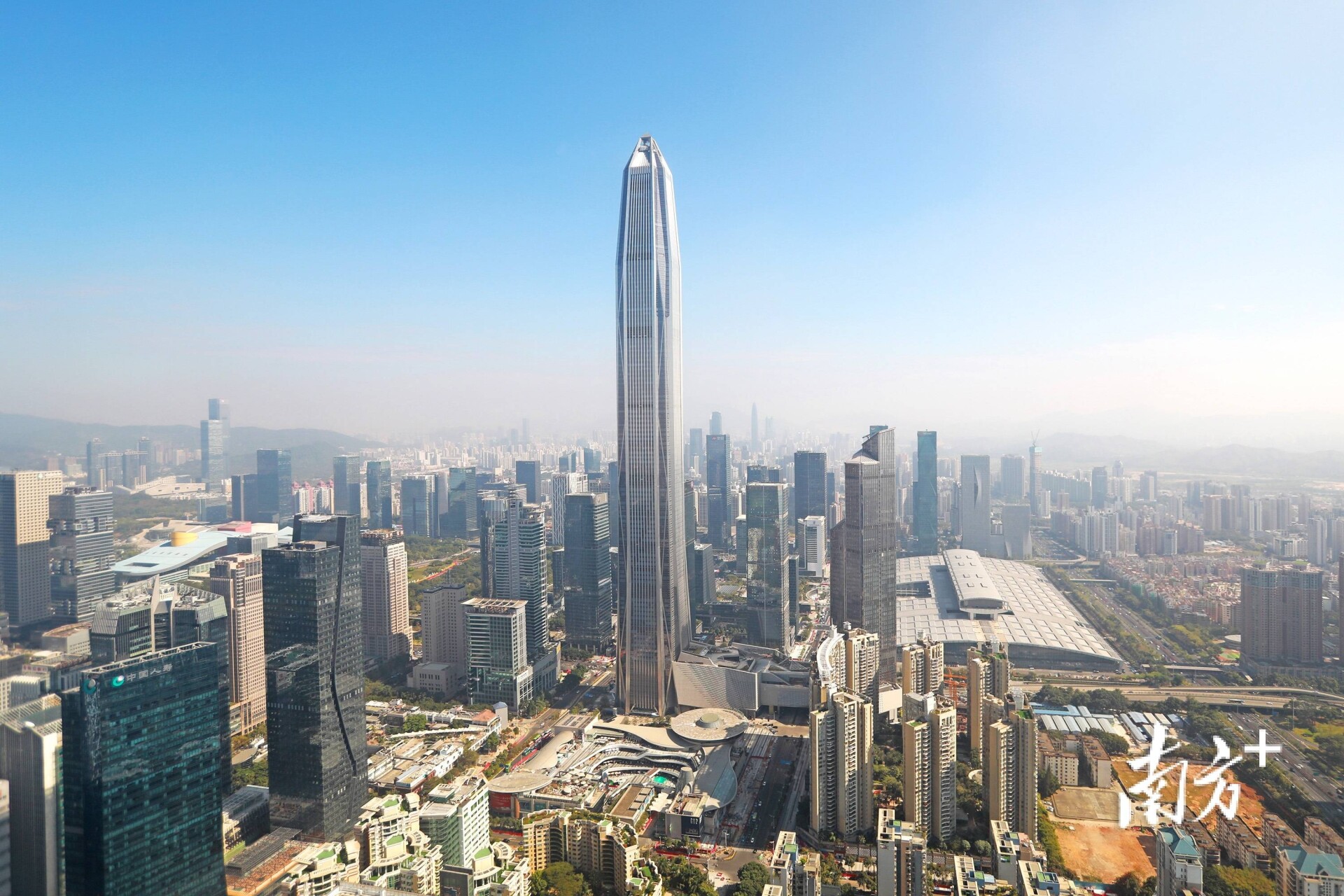
Shenzhen Metropolitan Area
Work to establish a "one main center, two sub-centers, one growth pole" layout, with Shenzhen as the main center, Dongguan and Huizhou as the sub-centers, and the Shenzhen-Shanwei Special Cooperation Zone as the growth pole. By 2030, an internationally recognized metropolitan area will take shape. By 2035, a Chinese-style, world-class, innovative, international, and modern metropolitan area will be fully developed.
Pearl River Estuary West Bank Metropolitan Area
The area will be built into an important growth pole of the Guangdong-Hong Kong-Macao Greater Bay Area, a globally influential advanced equipment manufacturing base, a new powerhouse for high-level openness and cooperation in the new era, and a high-quality development area that is suitable for living, working and traveling.
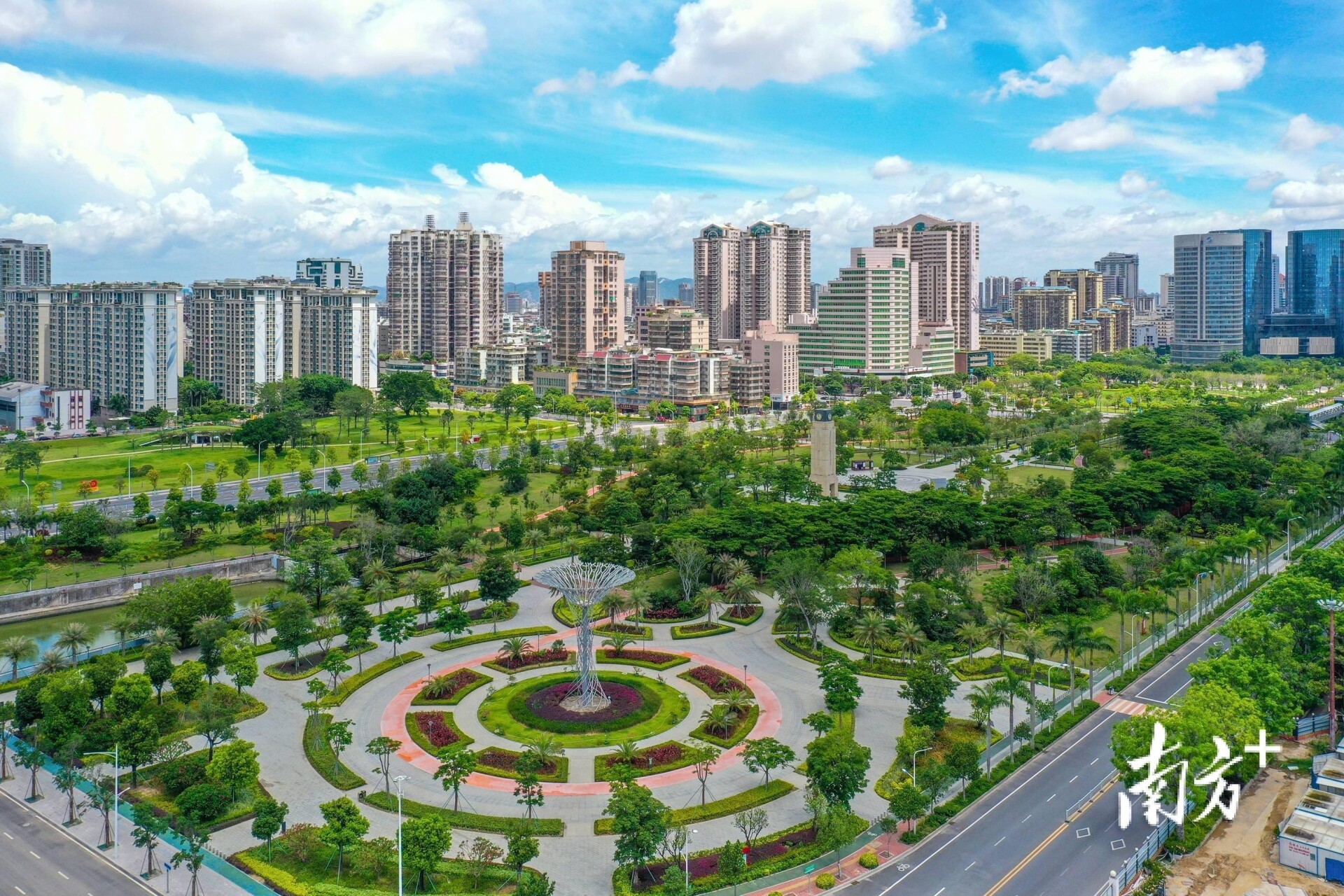
Shantou-Chaozhou-Jieyang Metropolitan Area
The area will be built into a key growth pole along the modern coastal economic belt, an important node for cooperation with other countries along the Belt and Road, a pioneering region for the connection between the coastal urban agglomeration of Guangdong, Fujian and Zhejiang and the Guangdong-Hong Kong-Macao Greater Bay Area, a regional logistics hub for Guangdong, Fujian and Jiangxi to expand coastal and overseas market, and an experimental zone for the integrated development of homogeneous metropolitan areas.
Zhanjiang-Maoming Metropolitan Area
The area will be developed into a model zone for the integrated implementation of major national strategies, a gateway hub for the new land-sea corridor in western China, and a key growth pole in the western segment of the modern coastal economic belt.
Source | 2025 Invest Guangdong
4、An expanding 1-hour transportation network
Guangdong boasts well-built, efficient sea, land, and air transportation facilities. The Guangdong-Hong Kong-Macao Greater Bay Area cities are accessible within one hour, eastern/western/northern Guangdong within two hours, and major cities in China/Southeast Asia within three hours. There are also 455 international cargo routes connecting with major countries and global ports.
Here are the highlights:
1. The annual vehicle flow on the Hong Kong-Zhuhai-Macao Bridge increased by 90% year-on-year.
2. Road and waterway investments totaled RMB2 14.22 billion, ranking among the top nationwide.
3. Investment in provincially administered railways reached RMB 108.29 billion, accounting for one-eighth of national railway investment.
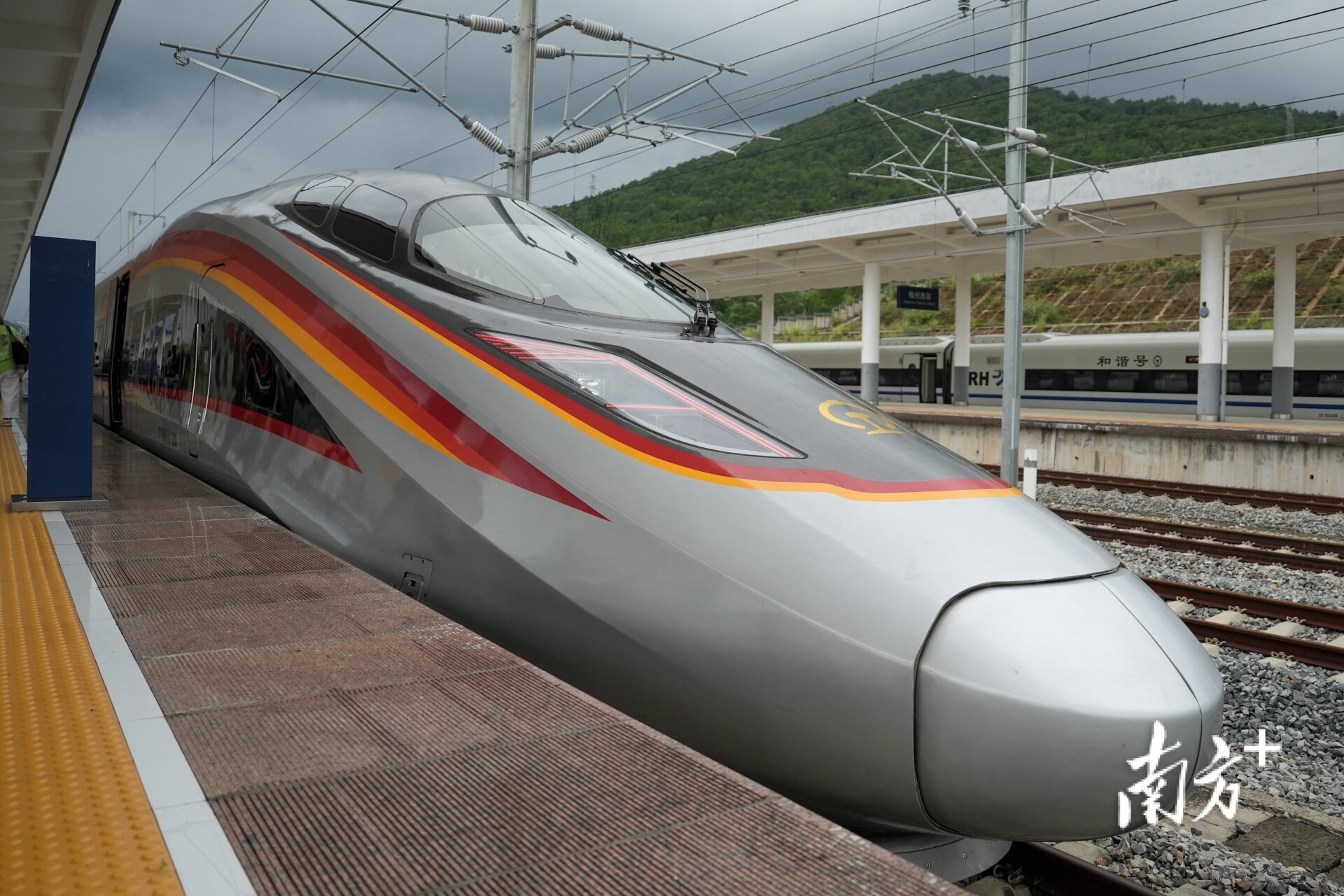
4. Expressway mileage exceeded 11,700 kilometers, leading the country for 11 consecutive years. There are now 33 inter-provincial passages, with at least five connecting to each neighboring land-based province. The Shenzhen–Zhongshan Link sets ten world records, while the Huangmaohai Sea-crossing Channel is the world's largest three-tower cable-stayed highway bridge.
5. Guangzhou Baiyun International Airport and Shenzhen Bao'an International Airport set record-high passenger volumes in 2024.
The province has nine airports: Guangzhou Baiyun International Airport, Shenzhen Bao'an International Airport, Zhuhai Jinwan Airport, Jieyang Chaoshan International Airport, Zhanjiang Wuchuan International Airport, Huizhou Pingtan Airport, Foshan Shadi Airport, Meizhou Meixian Airport, and Shaoguan Danxia Airport.
By the end of 2024, Guangzhou Baiyun International Airport and Shenzhen Bao'an International Airport set new records with 76.369 million and 61.48 million passengers, respectively.
6. Guangdong is the first province in China to build over 3,000 kilometers of high-speed railway, entering the era of the "high-speed rail ring".
The Guangzhou High-speed Railway Ring Line connects Guangzhou South Railway Station with Shenzhen, Shanwei, Jieyang, Chaozhou, Shantou, Meizhou, Heyuan, Huizhou, Dongguan, and ends at Guangzhou East Railway Station.
The Eastern Guangdong High-speed Railway Ring Line links Shantou with nine cities, including Chaoshan, Shenzhen, Dongguan, Huizhou, and Meizhou, returning to Shantou Station.

7. Guangdong's urban rail transit mileage has reached 1,477 kilometers, ranking first nationwide.
"Four railway ring lines" including Guangzhou-Foshan Ring Line South Section and Foshan-Dongguan Intercity Railway have been put into operation.
In May 2024, the Guangzhou-Foshan Ring Line South Section, Foshan-Dongguan Intercity Railway, Foshan-Zhaoqing Intercity Railway, and Dongguan-Huizhou Intercity Railway were fully interconnected, forming a 258-kilometer transportation artery spanning five cities: Huizhou, Dongguan, Guangzhou, Foshan, and Zhaoqing. This integration brings Foshan and Dongguan into Guangzhou's half-hour commuting circle, while Zhaoqing and Huizhou are now within Guangzhou's one-hour commuting circle, accelerating the formation of the "Greater Bay Area on Rails".
8. Guangdong ports set a new record for container throughput.
In 2024, Guangdon's ports handled over 77 million TEUs, ranking first nationwide and setting a new record. Among these, Guangzhou's Nansha Port handled 20 million TEUs, while Shenzhen Port recorded 33 million TEUs.
By the end of the 14th Five-Year Plan, Guangdong's railway network will exceed 6,500 kilometers, with high-speed rail coverage in counties reaching 74.2%. By the end of the 15th Five-Year Plan, coverage will rise to over 80%, enabling a one-hour travel circle within the Greater Bay Area, a 1.5-hour travel circle with other cities within the province, and a 3-hour travel circle with neighboring provincial capitals.
Source | 2025 Invest Guangdong
5、Rich cultural and tourism resources
Guangdong Province is the birthplace of the Maritime Silk Road, the cradle of modern Chinese revolution, and a pioneer in the country's reform and opening up initiative. As a key inheritor of Lingnan culture, it features diverse cultures like Cantonese, Hakka, and Chaoshan, each with unique characteristics in language, customs, lifestyle, and history.

World Heritage Sites in the region include the Kaiping Diaolou and Villages, as well as Danxia Mountain. Moreover, the area boasts a plethora of scenic attractions such as Luofu Mountain, Xiqiao Mountain, Dinghu Mountain, Huizhou West Lake, and Zhenhai Tower, among others.
Intangible cultural heritage
Guangdong boasts five items listed in the UNESCO Representative List of Intangible Cultural Heritage of Humanity, and 165 items recognized as national-level intangible cultural heritage.
Items listed in the UNESCO Representative List of Intangible Cultural Heritage of
Humanity : Cantonese opera, guqin (Ling nan school), paper-cutting (Guangdong style), shadow puppetry (Lufeng), and tea art (Chaozhou Kung Fu Tea Ceremony).
Items recognized as national-level intangible cultural heritage: Cantonese opera, Guangdong lion dance, Chaoyang Yingge dance, Duan inkstone craftsmanship, Cantonese embroidery, Xiangyunsha silk dyeing, dragon boat racing, and Shahe Rice Noodle traditional craftsmanship.

Landscaping
Guangdong was the first in China to afforest suitable barren hills, earning the title of "China's No. 1 province for barren hill afforestation".
The province has actively promoted the building of National Forest City, recognizing 210 provincial forest towns, building 256 forest villages, 102 ancient tree villages, 105 ecological villages with revolutionary heritage, and constructing 210 ancient tree parks.
Source | 2025 Invest Guangdong






